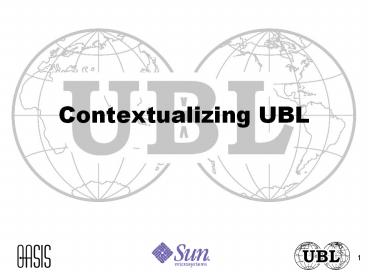Contextualizing%20UBL - PowerPoint PPT Presentation
Title:
Contextualizing%20UBL
Description:
UBL and the standards community ... Handcraft an XSD derivation, adhering to XSD rules ... Characterize this situation as a formally described business context ... – PowerPoint PPT presentation
Number of Views:19
Avg rating:3.0/5.0
Title: Contextualizing%20UBL
1
Contextualizing UBL
2
UBL and the standards community
- The UBL Library is intended to be an XML-based
core similar to UN/EDIFACT or X12 - Customization is expected by national and
industry groups and by smaller user communities - These changes are driven by real-world
requirements - A central ebXML registry/repository would serve
as a resource for user communities to view and
share customizations
3
UBLs goal is true business-to-business
interoperability
- Common data would mean the same and be handled
the same way - Customizations would be easily identified and
handled without software modification - Trading partner integration would be made
unnecessary
4
The EDI precedent
- EDI uses a prose-based subsetting approach
- UN/EDIFACT ? industry implementation guide
?trading partner IG ? departmental IG - Some XML vocabularies now use schema-based
extension - Core vocabulary extensions at each level
5
UBL leverages both approaches
- UBL picks an 80/20 point in supplying fields
likely to be needed - Then it allows both subsetting and extension to
the limit of XSDs abilities - This leverages existing XML software and
standards - UBL is defining a scheme for formal description
of business context and allowing these to be
associated with sets of data variations (actual
fields to subtract or add)
6
Successive sharing and customization
- The core standard is subsetted and extended
further each time - Each circle would have its own set of
schemas/namespaces and a linked set of business
context metadata
7
Context drivers
- ebXML identified eight top context drivers
- Business process
- Industry
- Product/service classification
- Geopolitical region
- Primary and supporting business roles
- System capabilities
- Legal constraints
- Supplying values for these eight parameters gives
you a business context (a place in the
eight-space) - UBL starts out as generic as possible typically
the business process must be identified
8
In Phase 1, UBL requires just context disclosure
- Customizers would
- Handcraft an XSD derivation, adhering to XSD
rules - Provide business context metadata, adhering to
UBL context derivation rules - One rule context drivers can be specialized, but
not reset (US?Maine, not US?Japan)
9
Phase 2 will involve machine application of
context
- Customizers will be able to describe the desired
schema changes in an abstract, recombinant way - These context rules will be applied by an engine
to input schemas to get contextualized schemas - Ultimately these would be created dynamically
- A registry would form the hub for these actions
- A subtle and difficult problem!
10
When the 80/20 point isnt sufficient
- Lets say a core UBL Address component requires a
street, city, country, etc. - Useful for software to know and act on
- But for parts delivery to a mobile oil-drilling
platform in international waters, the ship-to
information must be only GPS coordinates - Should be an extension of a UBL-based oil
industry standard
11
When business requirements and technical
abilities diverge
- Several actions are needed here
- Characterize this situation as a formally
described business context - Add GPS coordinate data as required fields
- Remove fields (city etc.) that are normally
required - Neither EDI subsetting nor XSD derivation allows
this last one even if combined
12
UBL proposes to increase interoperability even
here
- One alternative is to build a whole new core
- But this compromises the investment in software
developed for the UBL core - Another alternative is to build a prior core
an Ur-Library on which to layer the UBL
Library itself - Its base types would allow missing fields where
UBL doesnt (cardinality set to 0..1 or 0..n) - The types would be abstract
- UBL would become a restriction of these types
13
Customizing from the Ur-Library
- Customizers could derive from the Ur-Library if
necessary - And get the benefits of using well-defined types
underlying UBL - However, they wouldnt be able to claim UBL
conformance















![get [PDF] Download The Psychology of Later Life: A Contextual Perspective PowerPoint PPT Presentation](https://s3.amazonaws.com/images.powershow.com/10051127.th0.jpg?_=20240608107)




![READ [PDF] The Nordic Constitutions: A Comparative and Contextual Study (Hart Studies in PowerPoint PPT Presentation](https://s3.amazonaws.com/images.powershow.com/9916298.th0.jpg?_=20230804066)










